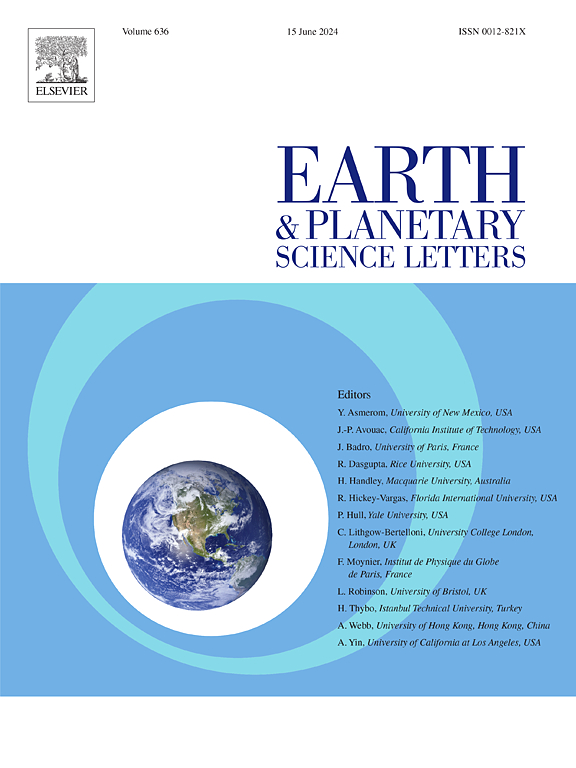Weak paleointensities from 1.6 Ga Greenland dykes: Further evidence for a billion-year period of paleomagnetic dipole low during the Paleoproterozoic
IF 4.8
1区 地球科学
Q1 GEOCHEMISTRY & GEOPHYSICS
引用次数: 0
Abstract
The Paleoproterozoic era is the longest in Earth's history, with significant changes hypothesised to have occurred in the deep Earth's physical and chemical conditions at this time. It has been suggested that the paleomagnetic field became weaker at this time (∼2.4 Ga) and remained weak for the next billion years. Paleomagnetism is intrinsically linked to, and is able to inform on, ancient deep Earth processes; a weak dipole strength sustained over this time period may have implications for both core and mantle evolution.
We test this hypothesis here in a two-fold approach: (1) A paleointensity study on the widespread ca. 1.6 Ga diabase/dolerite Melville Bugt dyke swarm. The swarm extends along the west coast of Greenland for more than 1000 km and intruded over ∼13 million years, capturing polarity reversals of Earth's magnetic field. (2) A detailed statistical analysis on the long-term trend in average dipole moment from an improved paleointensity dataset (PINT.org) that has recently undergone a major update.
Five of the Greenland dykes produce paleointensity results ranging from 1.4 μT to 5.1 μT (virtual dipole moment range 0.3–1.2 × 1022 Am2) during the mid-point of this extended period of ‘dipole low’. Our statistical study robustly confirms that this one-billion-year period was indeed associated with an anomalously weak dipole moment (2.7 × 1022 Am2) relative to 500-million-year intervals before and after, which were almost twice as strong. Sampling of more geographically diverse rocks from this time is needed to yield a clear picture of the long-term time evolution of the dipole moment.
来自 1.6 Ga 格陵兰堤坝的弱古密度:古近代十亿年古地磁偶极低值期的进一步证据
古近纪是地球历史上最长的时期,据推测,地球深部的物理和化学条件在这一时期发生了重大变化。有人认为,古地磁场在这一时期(2.4 Ga ∼ 2.4 Ga)变得较弱,并在接下来的十亿年中一直保持较弱的状态。古地磁与古老的地球深部过程有着内在联系,并能够为其提供信息;在这一时期持续较弱的偶极子强度可能会对地核和地幔的演化产生影响。我们在这里从两个方面对这一假设进行了验证:(1)对广泛分布的约 1.6 Ga 的辉长岩/辉绿岩 Melville Bugt 堤群进行古强度研究。该岩群沿格陵兰岛西海岸延伸 1000 多公里,侵入时间超过 1300 万年,捕捉到了地球磁场的极性反转。(2) 对最近经过重大更新的改进型古强度数据集(PINT.org)中平均偶极矩的长期趋势进行了详细的统计分析。在这一延长的 "偶极低 "时期的中点,格陵兰岛的五个堤坝产生了从 1.4 μT 到 5.1 μT(虚拟偶极矩范围为 0.3-1.2 × 1022 Am2)的古强度结果。我们的统计研究有力地证实,相对于之前和之后的 5 亿年,这 10 亿年的偶极矩(2.7 × 1022 Am2)确实异常微弱,而之前和之后的偶极矩几乎是前者的两倍。要清楚地了解偶极矩的长期时间演化,还需要对这一时期更多不同地理位置的岩石进行取样。
本文章由计算机程序翻译,如有差异,请以英文原文为准。
求助全文
约1分钟内获得全文
求助全文
来源期刊

Earth and Planetary Science Letters
地学-地球化学与地球物理
CiteScore
10.30
自引率
5.70%
发文量
475
审稿时长
2.8 months
期刊介绍:
Earth and Planetary Science Letters (EPSL) is a leading journal for researchers across the entire Earth and planetary sciences community. It publishes concise, exciting, high-impact articles ("Letters") of broad interest. Its focus is on physical and chemical processes, the evolution and general properties of the Earth and planets - from their deep interiors to their atmospheres. EPSL also includes a Frontiers section, featuring invited high-profile synthesis articles by leading experts on timely topics to bring cutting-edge research to the wider community.
 求助内容:
求助内容: 应助结果提醒方式:
应助结果提醒方式:


